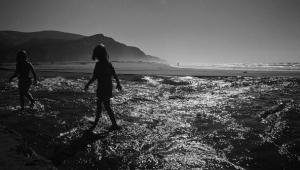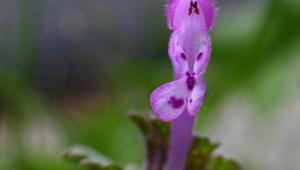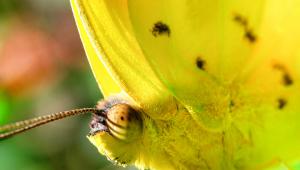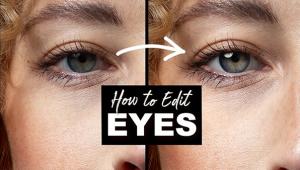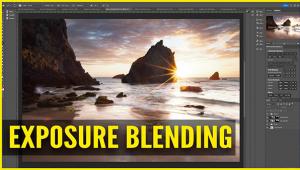Posing People Shots On The Road: Arranging For And Photographing Foreign Models
The approach I prefer is to arrange the models beforehand. The two great resources I use to get this done in most places in the world is a taxi driver or the hotel concierge. These people have knowledge, contacts, and experience in helping travelers find whatever they want, and if they don’t know whom to call they will know someone who does. As an example, when I was in Cambodia I hired a young man with a motorbike to take me around to the various ruins at Angkor Wat. I told him I wanted to photograph some traditional Cambodian dancers posing for me in the famous ruins, and he drove me to a dance school where he interpreted for me and helped arrange four young people in full costume for the afternoon of the following day. The shoot went very well. I got some great pictures (#1), and we all had a great time.

All Photos © 2010, Jim Zuckerman, All Rights Reserved
Whether I set up shots or shoot spontaneously—which I still do at times—it is important to know how to interact with the people in culturally respectful ways. It’s a good idea to ask your guide or driver about some of the do’s and don’ts you should be aware of before the photo session or when you want to photograph strangers on the street or in a village. For example, in Thailand you should never touch the top of someone’s head or sit with the bottom of your feet facing them. In a Muslim, country, never give anything to someone else with your left hand, and when you enter a Church anywhere in the world, take your hat off. In Israel the opposite is true. When entering a Synagogue, the head should be covered (this is true for conservative and orthodox Synagogues elsewhere, also). In many Asian cultures, it is considered terribly impolite to express anger publicly. Even when you are upset, a smile and a soft-spoken manner are not only very polite, it will help you get what you want a lot more than anger will.
If you want to prepare yourself before you go to a country, you can do a search on Google for something like “cultural mores Thailand” and you will find a lot written about any culture with which you want to become familiar.
Backgrounds And Locations
Never underestimate the importance of a background to make or break a picture. With travel photography, a background is especially important because it gives a sense of place. However, it can easily be distracting and/or unattractive if it’s not well chosen. For example, (#2) shows a classic Venetian background, and it enhances the portrait of the costumed Carnival participant. I balanced the exposure from the fill flash with the distant San Giorgio Island, and this is the kind of environmental portrait where the background plays an important role in making the shot so effective. The comparison picture (#3) doesn’t show enough of the background in my opinion, and the lamppost seems to be growing out of this person’s head. In addition, it’s a little too dark. This is the kind of background that is distracting rather than complementary. It still gives a sense of place, but there are too many problems with it. In both shots I had the same background but due to the composition, the exposure, and the shooting position one image looks good while the other one doesn’t work well.

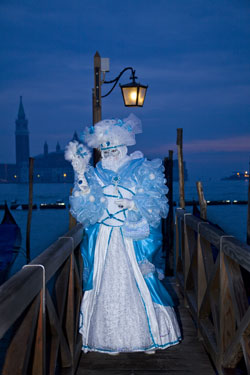
How do you choose a good background for a subject? Research, pre-visualization, and trial and error. I do a lot of research before I travel because I am constantly looking for places to shoot models. I print out possible locations, and then when I arrive I try to make the arrangements for hiring the models and getting them to the places I found. I also buy local postcards for sites that serve my purpose. For example, I discovered Gyeongbok Palace in Seoul, Korea from a postcard at my hotel, and I asked a young woman working at the reception desk if she would model for me in traditional Korean attire. She agreed in exchange for pictures that I promised to send her, and she also helped me rent the outfit from a local shop. The series of shots I was able to take (4 and 5) was a highlight of the trip.

Pre-visualization is the real key in choosing great backgrounds for the subjects you shoot. I start the pre-visualization process in my thinking by saying to myself, “What if…” or “Wouldn’t it be great if…” For example, when I was in the desert state of Rajasthan in India the Thar Desert is a sea of sand near Jaiselmer, and I thought it would be fantastic to have models positioned on one of the dunes. The brilliant colors of the Indian clothing against the blue sky would look awesome, so I inquired whether or not this kind of thing was possible to arrange, It was, and I got a fantastic group of images. You can see in (#6), that I used a wide angle lens placed very close to the foreground, and even though the defined ripples make up a predominant part of the picture, the models stand out beautifully and they are the focal point of the photograph.
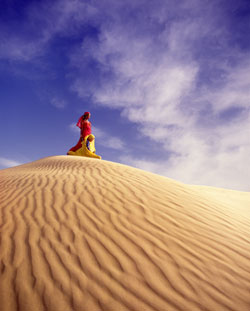
I did the same thing with a camel train (#7). On the same dunes, I hired some men to walk their camels on the crest of the dune. The sunset sky wasn’t very good that evening, so I used Photoshop to replace it. The conceptualization of this started when I came up with a best-case scenario for this location, and then I asked my local guide to help make it happen.
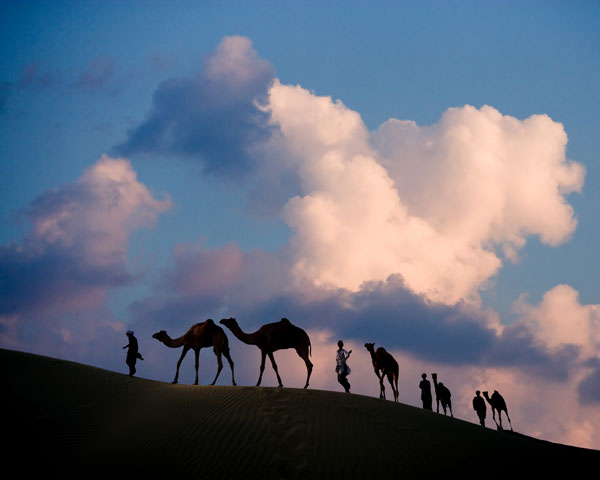
Classic backgrounds that almost always make winning shots are doorways, windows, archways, and corridors. I look for these things everywhere I go. A palace door offered a sensational backdrop in the photo of a Balinese dancer (#8), for example, and a simple oval window in a Burmese monastery gave me a wonderful portrait of four novice monks (#9). Similarly, I photographed a woman in period dress in the window of a 19th century house in Missouri Town, a recreation of an 1855 settlement near Kansas City (#10). I used a much more ornate window design in the Muslim section of Jodhpur, India to frame two models (#11). This kind of composition forces our attention on the subject and, at the same time, adds artistry to the picture both in color and in graphic design.
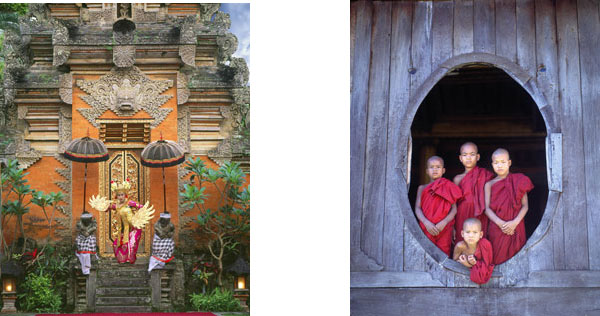


Framing a subject with a window is akin to using the graphic form of an arch to focus attention where you want it. That’s what I did in both (12 and 13). These are shots that were set up to look serendipitous—like I was lucky to be in the right place at the right time. In fact I instructed the models where to stand, what to do, and of course I chose the best time of day to get attractive lighting.

Nature also makes a great background. For subjects like a Bushmen hunting party in Namibia (#14), a natural background is the only thing that makes sense. It was tough to frame these young men without including too much clutter in the background, though, because this portion of the Namib Desert has a lot of vegetation. The telephoto portrait I made of one of the Bushmen (#15) included foreground grass to give a feeling of their environment, but I used the sky as a clean backdrop so our attention is not diverted from the subject by distracting graphic elements that might have been behind him.

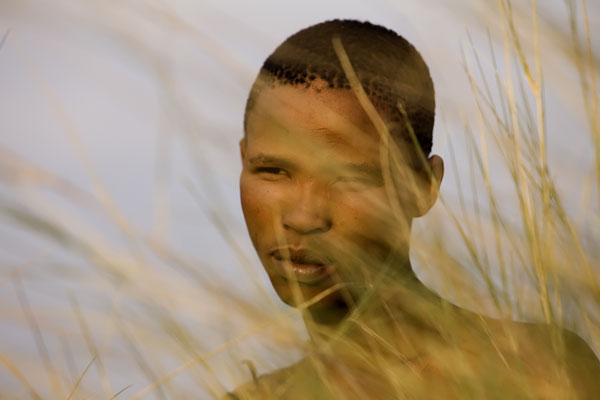
In Irian Jaya, which is the western portion of the island of New Guinea and part of Indonesia, I also used a natural backdrop to photograph warriors of the Dani tribe (#16). When I went to their village to do individual portraits, the background elements were very messy and visually unappealing—at least for my own sense of aesthetics. It was definitely authentic, but I prefer a cleaner look. Therefore, I used a telephoto lens to photograph the young woman (#17) covered in mud (this indicated she was in mourning for the loss of a loved one). The lens threw the background elements completely out of focus.

Ornate backgrounds, on the other hand, can help create outstanding images in some circumstances. I photographed a Javanese bride with a traditional set behind her in Blitar, Indonesia (#18), and the lady from whom I rented the clothing provided the backdrop. This is the typical set erected for the wedding party during a marriage ceremony.

Lighting
If you study the lighting in the pictures of foreign models in this section you will see that they were taken with two types of lighting. I used either soft and diffused light from an overcast sky or I took the pictures when the sun was close to the horizon at sunrise or sunset. These two lighting scenarios are best for outdoor shooting. Dawn and dusk offer photo opportunities as well, as you see in the Venetian Carnival photos, because the lighting is soft. I avoid midday sunlight whenever I can because the light is too harsh. When you expose for the highlights, as you should, the shadows that are created by direct sunlight tend to go black. This is especially unattractive on a face where the shadow from a protruding brow makes the eyes go dark and, at the same time, the nose is highlighted. In my opinion, the nose should never be highlighted no matter how attractive or interesting it may be.
The Papua New Guinea tribesman I photographed during the annual Sing Sing (#19) is a perfect example of what not to do. You should always avoid this kind of light on a person unless you are seeking revenge on a friend or foe and you want their picture to be as ugly as possible!

Breaking The Ice
Many photographers are uncomfortable or intimidated shooting strangers when they travel. If you relate to this, there is one way you can make it easier on yourself and, at the same time, have fun interacting with the people you encounter on your trip. When you show someone their image on your LCD monitor on the back of the camera, almost invariably you’ll get a smile of appreciation and then they want you to take more pictures—and everyone in the area wants their picture taken, too. This works especially well with children.

Model Releases
Most people don’t travel with the intention of selling their work. However, if you have a passion for photography, sooner or later the thought crosses your mind that it would be great to sell some of your images so you and your friends and family can see them published. It would also be nice to make back some of the money you’ve spent on camera gear, computer hardware and software, and travel. Therefore, let me discuss the issue of model releases.
In the past, model releases were required if a person’s face was recognizable and if the images of him or her might be used for advertising purposes as opposed to editorial layouts. Editorial usually refers to newspapers and magazines and advertising refers to everything else.
Today, due to our litigious society, stock agencies and some of their clients—as well as other end users of photography—have been sued in a variety of circumstances. Corporations with deep pockets attract lawsuits, and therefore many of them now demand that photographers get model releases for everyone—recognizable or not. This means that if a person is in a Carnival costume and not one square inch of skin is showing, a release would still be required. After all, the person inside the costume could claim that he or she was in there when the picture was taken. I have submitted silhouettes of people where the agency wanted a release, as in (#20). Sometimes I’ve zoomed in tight and photographed from the neck down, and an agency still required a release to sell the image in the advertising arena. Editorial usage is still more relaxed, but sometimes publishers require releases as a precaution against frivolous lawsuits.
There are many different kinds of model releases you can use, but an industry standard is the one that the stock agency Getty uses. Here is a link to several releases that are available to all photographers without charge: http://contributors.gettyimages.com/article.asp?article_id=1767.
I used to have model releases translated into other languages when I traveled. Now I don’t. If I pay models, as I almost always do, then part of the deal is that they must sign the release in English. That makes it very easy for an American stock agency or publisher to understand it.
When I photograph a tribal village, it’s obviously very difficult and certainly inconvenient to get releases from everyone. In addition, many people in these circumstances are illiterate and can’t write their own names. I’ve consulted with the legal department of my stock agency, and they accept a blanket release that covers the entire group of people signed by the chief of the village.
- Log in or register to post comments


